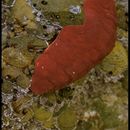Morphology
provided by EOL authors
Has eight butterfly-shaped valves plates.(2) The valve plates often break, but the Chiton can repair them. (3) The plates are covered by a thick and leathery mantle. The dorsal surface is usually red/brown, while the underside is usually yellow or orange (2) The lighter fibrous parts around the edges are the Chiton’s gills. (4) Considered the most highly modified Chiton, and can weigh around 4.4 pounds(1) About 44% of their body weight is blood (2) The radular teeth are hardened by a magnetite cap. (2) The teeth have so much magnetite in them that they can be picked up by a magnet (3) During low tide, the Chiton can absorb oxygen from the atmosphere if necessary. (3) It can live for up to 25 years. (4)
Habitat
provided by EOL authors
The stelleri hides among red algae/kelp forests for camouflage and food(1)
Trophic Strategy
provided by EOL authors
Feeds mostly on red algae, but sometimes feed on brown or green algae.(2) Uses tongue-like radula to scrape algae from rocks (1) One predator is the snail Ocenebra lurida (2)
Reproduction
provided by EOL authors
They spawn from March to May in California, and after hatching, larvae swim for about 20 hours before settling. (1)
Comprehensive Description
provided by EOL authors
The cryptochiton stelleri was named after Georg Wilhelm Steller, who was a Russian naturalist living in Alaska. (1)
Reproduction
provided by EOL authors
The gumboot chiton, like all chitons, mates externally, with the male releasing sperm and the female releasing eggs into the water. When fertilized, eggs develop through a stage as a trophoblast before growing into a juvenile. (1) Most commonly, eggs develop while free-floating, although some species retain them in the mantle cavity and one gives birth to live young. (2)
General Ecology
provided by EOL authors
The gumboot chiton lives in temperate to cold waters from the coasts of California and Japan up to Alaska and Kamchatka. (1) Much of its life is spent in tide pools, where it subsists on algae and seaweed during the nighttime. Its predators are few, although some predatory snails have been known to attempt to kill it (although few can cut farther than the outer mantle). It also has been known to have commensal relationships with some isopods and shrimp that take refuge in its gills. (1)
Brief Summary
provided by EOL authors
The gumboot chiton (Cryptochiton stelleri), also called the Great Pacific Chiton, is a mollusk of class Polyplacophora. Most recognizable by its physical appearance (which has earned it its nickname, the “wandering meatloaf”), C. stelleri is a fairly common sight in tide pools and shallows around the northern regions of the Pacific Rim. (1)
Physiology
provided by EOL authors
C. stelleri translates from Latin to “Steller’s Hidden Chiton”, so named because the eight valves present in all and external in most chitons are covered by the animal’s fleshy mantle, which comes in shades of red, brown, and orange and is pebbled and tough. The chiton’s underside is largely composed of its muscular foot, flanked by its two gills on each side. The mouth and anus are at the anterior and posterior ends, respectively, although there is no head or tail to speak of. (1) (2) The nervous system is simple, with no real ganglion, although a pedal nerve cord runs the length of the creature below the foot. (2) Internally, the gumboot chiton is not unlike most other chitons. The gut extends the length of the creature, with a stomach towards the anterior end. Digestion is aided by enzymes injected into the stomach from a gland. (2) Oxygen is synthesized from the gills, then introduced into the blood via a pair of auricles (one for each gill). The blood is then pumped into the aorta (and the body) with a powerful ventricle. (1) Excretion of nitrogenous waste is accomplished through a pair of nephridia. The single gonad is large and occupies the top of the body, releasing into a pair of gonopores in front of those used by nephridia. (3)

